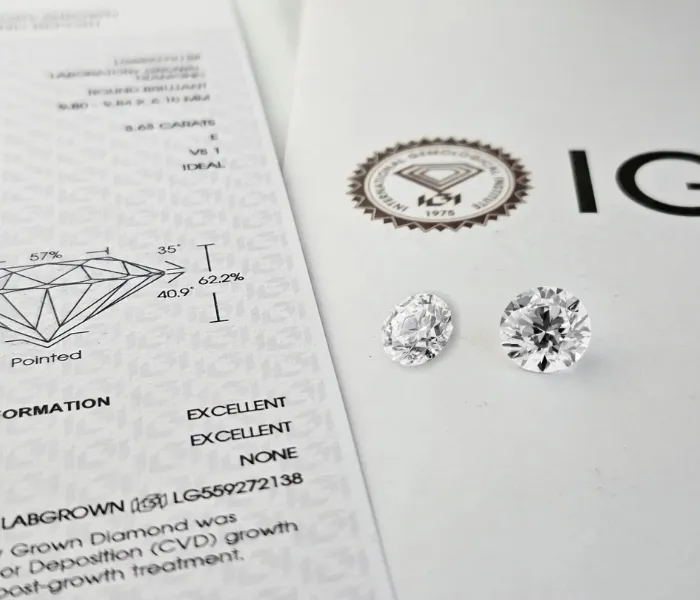Why aren't customers buying from my jewelry website?
A common question we hear from online jewelry retailers is:
"I have a lot of visitors to my site, but they don't buy anything. Why?"
Some typical signs include:- Abandoned carts
- Enquiries going cold
- A large number of visitors, but very few conversions
- Overall, no purchases happening
Based on our extensive experience working with hundreds of diamond jewelry e-retailers globally, here are some common reasons—each of which can individually or collectively impact your sales:
1. Overuse of Stock Photos and Videos
Your website may look beautiful, but too many stock images or polished videos can backfire. They create a sense of distance and mistrust. It’s okay if your workshop is messy, or your showroom is small—what matters is authenticity. Always include real photos of your workspace, team, and actual jewelry. That’s what builds trust.
2. No Physical Address Listed
Many jewelry websites only display a phone number and an enquiry form, avoiding a physical address either because they operate from a small setup or for security concerns. However, adding a physical address (even if it’s just a small studio) can significantly boost buyer confidence. It shows legitimacy and accountability.
3. Unexpected VAT, Sales Tax, or High Shipping Costs at Checkout
One of the biggest turn-offs is when the final price suddenly increases due to added taxes or shipping fees. This causes “pricing shock” and leads to abandoned carts. Always display prices inclusive of taxes and shipping to maintain transparency.
4. Product Photos That Look Too Perfect
Excessively polished product images, especially those generated by AI or CAD, can make buyers suspicious. If the photos look too good to be true, users may assume the real product won’t match. Wherever possible, add actual product images, ideally photographed under normal lighting. It helps bridge the trust gap.
5. Generic or Impersonal "About Us" Page
High-value customers—especially those buying diamonds—do check your “About Us” page. Yet many stores copy generic AI-generated content. Instead, create a personalized story. Mention the founders, show real photos, and share your background or why you started the business. Let the buyer feel they’re buying from real people.
6. Reviews That Lack Honesty
Having 100 perfect 5-star reviews can actually seem suspicious. It’s better to show 10 real, truthful reviews, including the occasional negative one—along with your response. Buyers appreciate honesty and transparency more than perfection.
7. Missing Trust Badges or Affiliations
If you’re a member of credible organizations like Jewelers of America, American Gem Society, or others—display these badges prominently. Even better, link them to your official membership page. These add serious trust value.

8. Vague or Hidden Return and Shipping Policies
Buyers—especially serious ones—do read the fine print. If your return or shipping policy isn’t clear, they’ll hesitate. A clear and liberal return policy encourages purchases and reduces buying friction.
9. Avoid AI Chatbots
Automated AI-powered chatbots irritate buyers. Instead, encourage customers to call or speak with a real human. For expensive purchases like diamond jewelry, personal interaction builds trust and increases the chances of conversion.

10. Build Buyer Confidence With Verified Security and Trust Badges
Reassure your customers by displaying verified security and trust badges on your website. Get your site audited by reputed third-party security services—especially for payment processing and data privacy. Include SSL certificates, and consider subscribing to services like Norton Shopping Guarantee or TRUSTe. These badges signal credibility and make buyers feel safe when making high-ticket purchases.

11. Don’t Mask the Diamond Lab Certificate Report Number
Some jewelry e-retailers intentionally blur or hide the report number on lab certificates (like GIA or IGI) to prevent buyers from cross-checking the same diamond on other websites. This is usually done programmatically or by photoshopping the certificate.
I strongly advise against this practice. It comes across as manipulative and damages trust. Transparency is key in high-value transactions. If your pricing, service, and overall experience are strong, genuine buyers will choose you—regardless of whether they’ve seen the diamond listed elsewhere.
12. Offer Financing Options
Jewelry is expensive, and many buyers expect flexible payment options. Offering financing can significantly reduce hesitation and cart abandonment.
Partner with reputable financing providers in your region—such as Affirm, Klarna, or PayJustNow— to give your customers the ability to buy now and pay later. This not only improves affordability but also boosts your conversion rate.



